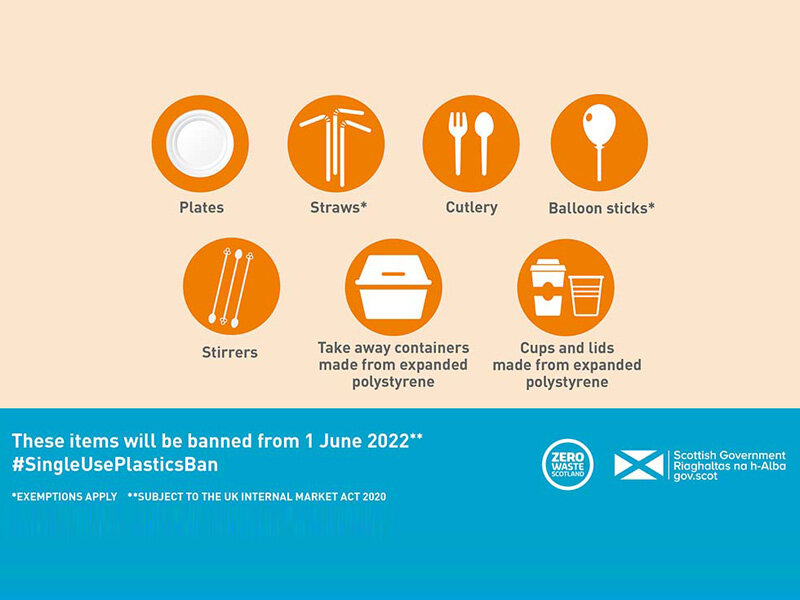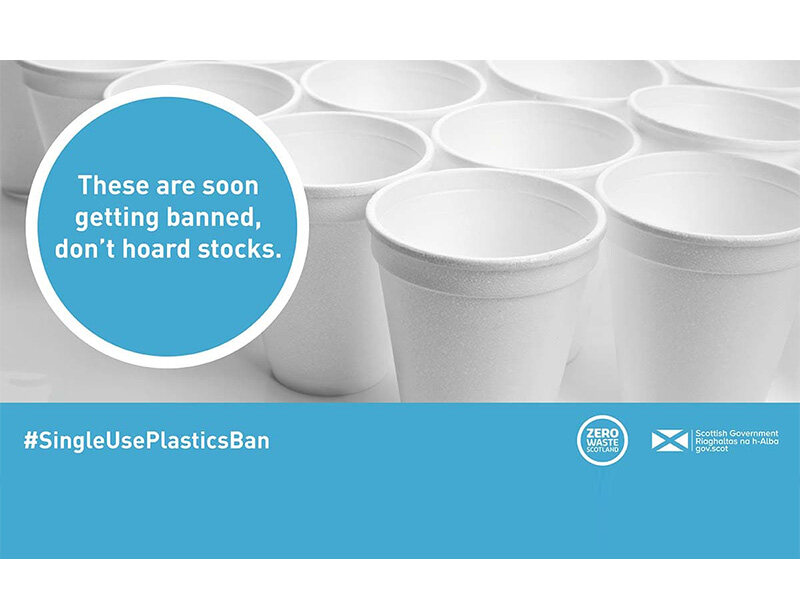Scotland set to ban single-use plastics from June 2022
Every year, hundreds of millions of pieces of single-use plastic are wasted in this country. They litter our coasts, pollute our oceans and contribute to the climate emergency.
From 1 June 2022, Scotland will become the first UK nation to ban some of the most environmentally damaging single-use plastic items.
What’s included in the new legislation?
The ban will apply to the following single-use items:
Legislation includes exemptions for single-use plastic straws, to make sure that those who need them for independent living or medical purposes can still get access to them.
Businesses should ensure they have reviewed the implications of this when managing stock levels and to ensure they understand when these items can be used.
Businesses, including individuals operating a business, cannot supply the items as part of their business activities. This would include selling the items or distributing the items by another means, such as providing for free. For example, cafes, bars, restaurants and hotels cannot provide these items to their customers or guests.

Getting ready for the new legislation
Now that the final regulations have been published, businesses affected by the changes have time to prepare for the new laws coming into force and are encouraged to think about managing stock levels of the banned items, in order to avoid waste. We would encourage businesses to be proactive and start shifting to alternatives (such as reusable items) so their single-use plastics stock is used up when regulations come into force on 01 June 2022.
When switching to single-use plastics substitutes, businesses should consider this:
Banning single-use plastic items can be a big win for some environmental impacts, such as the marine environment.
However, simply switching to other single-use items made of alternative materials can lead to other environmental impacts.
Businesses may wish to think about how reusables could fit into their operations and where this is not possible, ensure that single-use substitutes are carefully considered.

Making more sustainable choices: moving away from single-use
With pressure for businesses to take action on plastics, the guidance below will help food producers and hospitality businesses to assess what meaningful action can be taken.
Instead of focusing on plastic, we recommend that focus is broadened to tackle all single-use items regardless of what material they are made from. Single-use plastic items are common and have received a lot of attention, but single-use items made from alternative materials aren’t a simple solution. They still consume limited resources, contribute to Scotland’s carbon emissions and they are still disposed of after one use. Instead, the priority should be to reduce all single-use items, regardless of the material.
The following hierarchy can help.
Prioritising actions at the top will have the biggest impact. It may take time, and imagination, to deliver these changes, but ultimately, they will make the changes needed to transform our high-waste society.
1. Rethink your operations to remove the need for single-use items in the first place.
Wherever possible, businesses should aim to move away from single-use items. Examples of how to do this include:
2. Rethink your set up to reduce demand for single-use items.
If it is not possible to remove certain single-use items altogether, the focus should be on reducing the demand from customers for these products. This can be done by making reusable alternatives more appealing or reducing ease of consumption (e.g. making available when requested, rather than automatically). Examples of how to do this include:
3. Only where you cannot avoid single-use items, choose materials that have the lowest environmental impact.
All single-use items have an environmental impact, but this can vary depending on the material the item is made of and how it is manufactured. Understanding the impact of different products can help you to make an informed decision. Consider the following questions:
4. Make sure all single-use items are actually recycled or composted.
It is important to ensure that the single-use items you supply to customers are disposed of appropriately after use, whether this is on your premises or elsewhere.
For items that will be disposed on your premises, you should:
Resource: VisitScotland, Zero Waste Scotland